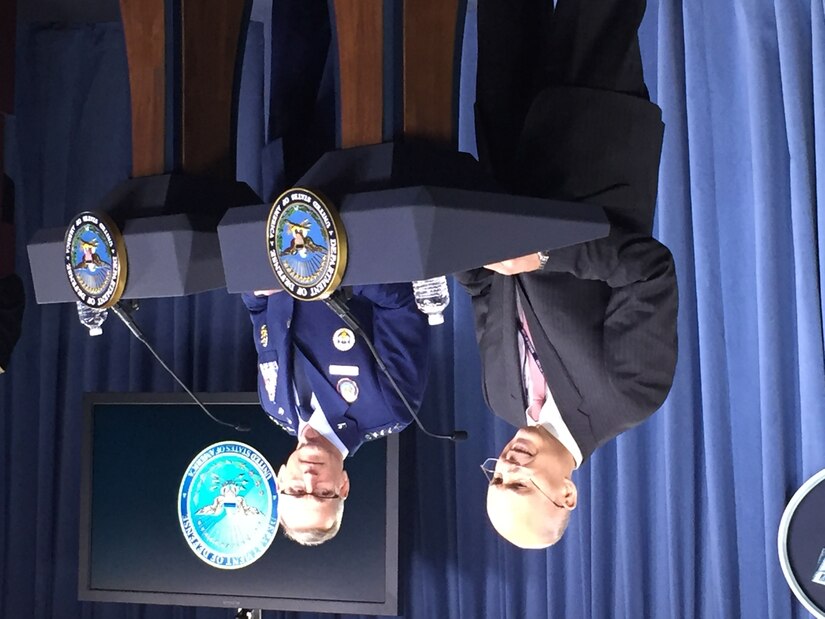By Jim Garamone, DoD News, Defense Media Activity
WASHINGTON -- More than 7,000 service members -- National
Guard and active duty -- are standing by ready to assist as Hurricane Florence
hits the Carolina coast, DoD officials said here today.
Defense Secretary James N. Mattis and Deputy Defense
Secretary Patrick M. Shanahan are monitoring the Category 2 hurricane and the
department is “leaning forward” to help civilian agencies as the storm
approaches.
“The secretary is also receiving reports throughout the day
on actions the military services are taking to protect the safety and
well-being of the military community, and ensure the readiness of DoD
installations in the region affected by Hurricane Florence,” Kenneth P.
Rapuano, assistant secretary of defense for homeland defense and global
security, said at a Pentagon news conference.
‘Dangerous Storm’
Both Rapuano and U.S. Northern Command commander Air Force
Gen. Terrence J. O'Shaughnessy called Hurricane Florence a “dangerous storm”
and urged Americans to listen to the warnings from state and local officials.
O’Shaughnessy also commands North American Aerospace Defense
Command.
Outer bands of the storm have already started hitting the
coast and officials said there are already winds exceeding 100 mph in some
areas. The storm surge has hit in North and South Carolina and the storm is
expected to slow down and deposit huge amounts of rain.
DoD is already working with the Federal Emergency Management
Agency to pre-position helicopters, vehicles and supplies. The department is
prepared to assist FEMA and our other federal partners in supporting the
affected regions, Rapuano said.
O’Shaughnessy said DoD assets have virtually surrounded the
area where the storm is expected to make landfall.
Positioning Forces
“We are proactively positioning forces now to respond from
the north, from the south, from the east and from the west, across the full
spectrum of DoD capabilities at every level -- by air, by sea and by land,” the
general said.
Fort A.P. Hill, Virginia; Joint Base Bragg, North Carolina;
North Auxiliary Airfield, South Carolina; and Maxwell Air Force Base in Alabama
are staging areas for FEMA.
About 80 light/medium tactical vehicles are staged at Fort
Stewart, Georgia, set to respond quickly once Florence passes through the area.
These trucks are high-water-clearance vehicles which can carry supplies or
first responders. These vehicles proved their worth in this type of situation
last year during Hurricane Harvey in Houston.
At Hunter Army Airfield, Georgia, there are 35 helicopters
available for search-and-rescue operations. A similar unit is at Fort Bliss,
Texas, ready to move forward.
At Fort Bragg, there are 40 high-wheel vehicles for rescue
and transportation, as well as seven helicopters staged for use in search and
rescue and recovery missions, the general said.
The USS Kearsarge amphibious assault ship and the USS Arlington
amphibious transport dock ship are following behind Florence. These vessels
have Navy and Marine personnel, 16 helicopters and six MV-22 Osprey tilt-rotor
aircraft.
At Moody Air Force Base, Georgia, the Air Force has six
HH-60 helicopters, two HC-30 aircraft and four pararescue teams at the ready.
At Tyndall Air Force Base in Florida, 1st Air Force will
provide robust command-and-control, air operations support to the DoD effort.
This will include airborne command-and-control assets.
‘Ready to Respond’
“North Carolina, South Carolina, Virginia and Georgia are
all home to well-known military bases and installations, and the secretary of
defense is given authority for life-saving and life-sustaining actions in order
to make DoD capabilities immediately available, and local commanders are
proactively positioning forces and equipment to be ready,” O’Shaughnessy said.
“At the state level, National Guard units, whether Army or Air, under the
authority of their governors, are ready to respond to the individual and
oftentimes neighboring states' needs.”
Mattis has activated dual-status commanders in North
Carolina, South Carolina and Virginia to provide seamless command and control
over assigned active duty and National Guard forces.
Rapuano said U.S. Transportation Command is staging and
prepositioning FEMA resources. “The Defense Logistics Agency is directly
supporting FEMA logistics with the procurement and distribution of relief
commodities, including food, fuel and water,” he said.
The U.S. Army Corps of Engineers is also directly supporting
FEMA and is poised to support flood mitigation, temporary emergency power,
temporary roofing and debris removal, Rapuano said.
The National Geospatial-Intelligence Agency will provide
imagery analysis and assessment, he said.

No comments:
Post a Comment